HP Vectra VL 5-xxx User Manual

User’s Guide
HP Vectra VL
5/xxx

Notice
The information contained in this document is subject to change without notice.
Hewlett-Packard makes no warranty of any kind with regard to this material, including, but not limited to, the implied warranties of merchantability and fitness for a particular purpose. Hewlett-Packard shall not be liable for errors contained herein or for incidental or consequential damages in connection with the furnishing, performance, or use of this material.
This document contains proprietary information that is protected by copyright. All rights are reserved. No part of this document may be photocopied, reproduced, or translated to another language without the prior written consent of Hewlett-Packard Company.
CompuServeTM is a U.S. registered trademark of CompuServe Inc.
Microsoft®, MS®, MS-DOS® and Windows® are U.S. registered trademarks of Microsoft Corporation.
Pentium® is a U.S. registered trademark of Intel Corporation.
Hewlett-Packard France
Commercial Desktop Computing Division
38053 Grenoble Cedex 9
France
ã 1996 Hewlett-Packard Company

User’s Guide

WARNING
Who this Manual is For
This manual is for anyone who wants to:
•Set up the PC for the first time
•Configure the PC
•Add accessories to the PC
•Troubleshoot problems on the PC
•Find out where to get more information and support.
Important Safety Information
If you have any doubt that you can lift the PC or display safely, do not try to move it without help.
For your safety, always connect the equipment to a grounded wall outlet. Always use a power cord with a properly grounded plug, such as the one provided with this equipment, or one in compliance with your national regulations. This PC is disconnected from the power by removing the power cord from the power outlet. This means the PC must be located close to a power outlet that is easily accessible.
For your safety, never remove the PC’s cover without first removing the power cord from the power outlet, and any connection to a telecommunications network. Always replace the cover on the PC before switching it on again.
To avoid electric shock, do not open the power supply.
This HP PC is a class 1 laser product. Do not attempt to make any adjustment of the laser units.
iv

Important Ergonomic Information
It is strongly recommended that you read the ergonomic information before using your PC.
For Windows 95 users, open the Start menu in the task bar and select Help. Then double-click on the help topic “Working in Comfort”.
For Windows for Workgroups (Windows 3.11) users, open the Program Manager, open the program group “HPUtils”, and double-click on the “HP User Tools” icon. Then click on “Working in Comfort” in the page tagged “Information”.
v

vi

Contents
1 Setting Up and Using Your PC
Unpacking Your PC . . . . . . . . . . . . . . . . . . . . . . . . . . . . . . . . . . . . . . . . . 2 Connecting the Mouse, Keyboard, Display and Printer . . . . . . . . . . . 3
Connections for Models with Integrated Video Display. . . . . . . . . . . . . . . 3 Connections for Models with MGA Millennium Video Board. . . . . . . . . . . 4
Connecting to a Network . . . . . . . . . . . . . . . . . . . . . . . . . . . . . . . . . . . . 5 Connecting Audio Accessories . . . . . . . . . . . . . . . . . . . . . . . . . . . . . . . 6 Connecting the Power Cables . . . . . . . . . . . . . . . . . . . . . . . . . . . . . . . . 7 Your PC’s Hardware Control Panel . . . . . . . . . . . . . . . . . . . . . . . . . . . . 8 Starting and Stopping Your PC. . . . . . . . . . . . . . . . . . . . . . . . . . . . . . . . 9
Starting Your PC. . . . . . . . . . . . . . . . . . . . . . . . . . . . . . . . . . . . . . . . . . . . . . 9 Starting the PC for the First Time . . . . . . . . . . . . . . . . . . . . . . . . . . . . . . 10 Stopping Your PC . . . . . . . . . . . . . . . . . . . . . . . . . . . . . . . . . . . . . . . . . . . . 12
Setting Passwords . . . . . . . . . . . . . . . . . . . . . . . . . . . . . . . . . . . . . . . . . 13
Setting an Administrator Password . . . . . . . . . . . . . . . . . . . . . . . . . . . . . 13
Setting a User Password . . . . . . . . . . . . . . . . . . . . . . . . . . . . . . . . . . . . . . 14
Using Power Management . . . . . . . . . . . . . . . . . . . . . . . . . . . . . . . . . . 15
Additional Information and Help. . . . . . . . . . . . . . . . . . . . . . . . . . . . . 15
2 How to Install Accessories In Your PC
Accessories You Can Install . . . . . . . . . . . . . . . . . . . . . . . . . . . . . . . . . 18
vii

Removing and Replacing the Cover. . . . . . . . . . . . . . . . . . . . . . . . . . 19
Removing the Cover . . . . . . . . . . . . . . . . . . . . . . . . . . . . . . . . . . . . . . . . . 19 Replacing the Cover after Installing Accessories . . . . . . . . . . . . . . . . . . 19
Moving and Replacing the Power Supply . . . . . . . . . . . . . . . . . . . . . 20
Installing Memory. . . . . . . . . . . . . . . . . . . . . . . . . . . . . . . . . . . . . . . . . 21
Installing Main Memory. . . . . . . . . . . . . . . . . . . . . . . . . . . . . . . . . . . . . . . 21 Installing an Optional Cache Memory Module . . . . . . . . . . . . . . . . . . . . . 23 Installing a Video Memory Upgrade (Integrated Video Models) . . . . . . 24 Upgrading the MGA Millennium Board Memory . . . . . . . . . . . . . . . . . . . 26
Installing Mass Storage Devices . . . . . . . . . . . . . . . . . . . . . . . . . . . . . 28
Connecting IDE Devices . . . . . . . . . . . . . . . . . . . . . . . . . . . . . . . . . . . . . . 28 Configuring an IDE Device After Installation . . . . . . . . . . . . . . . . . . . . . 29 Installing an IDE Hard Disk Drive in the Rear Shelf . . . . . . . . . . . . . . . . 30 Installing an IDE Hard Disk Drive in the Bottom Shelf. . . . . . . . . . . . . . 31 Installing a Tape Drive in the Bottom Shelf . . . . . . . . . . . . . . . . . . . . . . . 33
Installing Accessory Boards . . . . . . . . . . . . . . . . . . . . . . . . . . . . . . . . 35
Configuring Accessory Boards with Plug and Play . . . . . . . . . . . . . . . . . 35 Configuring non-Plug and Play ISA Accessory Boards . . . . . . . . . . . . . . 35 Installing the Board . . . . . . . . . . . . . . . . . . . . . . . . . . . . . . . . . . . . . . . . . . 36
Installing a BNC Coax Adapter. . . . . . . . . . . . . . . . . . . . . . . . . . . . . . 38 Installing an OverDrive Processor . . . . . . . . . . . . . . . . . . . . . . . . . . . 40 Installing the Security Bracket . . . . . . . . . . . . . . . . . . . . . . . . . . . . . . 42
3 Troubleshooting Your PC
viii

Solving Problems . . . . . . . . . . . . . . . . . . . . . . . . . . . . . . . . . . . . . . . . . . 44
HP Summary Screen . . . . . . . . . . . . . . . . . . . . . . . . . . . . . . . . . . . . . . . 44
If Your PC Does Not Start Properly. . . . . . . . . . . . . . . . . . . . . . . . . . . 45
Display is Blank and There Are No Error Messages . . . . . . . . . . . . . . . . 45 If You Cannot Start Your PC from a Modem . . . . . . . . . . . . . . . . . . . . . . . 47 If a POST Error Message is Displayed . . . . . . . . . . . . . . . . . . . . . . . . . . . 47
If You Cannot Turn Off Your PC. . . . . . . . . . . . . . . . . . . . . . . . . . . . . . 49 If Your PC Has a Hardware Problem. . . . . . . . . . . . . . . . . . . . . . . . . . 49
Display Does Not Work Properly. . . . . . . . . . . . . . . . . . . . . . . . . . . . . . . . 49 If Your Keyboard Does Not Work . . . . . . . . . . . . . . . . . . . . . . . . . . . . . . . 51 If Your Mouse Does Not Work . . . . . . . . . . . . . . . . . . . . . . . . . . . . . . . . . . 51 If Your Printer Does Not Work. . . . . . . . . . . . . . . . . . . . . . . . . . . . . . . . . . 52 If the Flexible Disk Drive Does Not Work. . . . . . . . . . . . . . . . . . . . . . . . . 53 If the Hard Disk Does Not Work . . . . . . . . . . . . . . . . . . . . . . . . . . . . . . . . 54 If the CD-ROM Drive Has a Problem. . . . . . . . . . . . . . . . . . . . . . . . . . . . . 55 If an Accessory Board Does Not Work . . . . . . . . . . . . . . . . . . . . . . . . . . . 56
If Your PC Has a Software Problem . . . . . . . . . . . . . . . . . . . . . . . . . . 57
If You Have Forgotten Your Password . . . . . . . . . . . . . . . . . . . . . . . . . . . 57 If Your Application Software Does Not Work . . . . . . . . . . . . . . . . . . . . . . 58 If the Date and Time are Incorrect . . . . . . . . . . . . . . . . . . . . . . . . . . . . . . 58
If You Have a Network Problem . . . . . . . . . . . . . . . . . . . . . . . . . . . . . 58 If Your PC Has an Audio Problem . . . . . . . . . . . . . . . . . . . . . . . . . . . . 59 Changing the Battery. . . . . . . . . . . . . . . . . . . . . . . . . . . . . . . . . . . . . . . 61 Technical Information. . . . . . . . . . . . . . . . . . . . . . . . . . . . . . . . . . . . . . 63
ix

System Board Switches . . . . . . . . . . . . . . . . . . . . . . . . . . . . . . . . . . . . . . . 63 Power Consumption . . . . . . . . . . . . . . . . . . . . . . . . . . . . . . . . . . . . . . . . . 64 IRQs, DMAs, and I/O Addresses Used by Your PC . . . . . . . . . . . . . . . . . 65 Integrated Video Graphic Information . . . . . . . . . . . . . . . . . . . . . . . . . . . 66
HP Setup Program . . . . . . . . . . . . . . . . . . . . . . . . . . . . . . . . . . . . . . . . 66
4 Hewlett Packard Support and Information Services
Introduction . . . . . . . . . . . . . . . . . . . . . . . . . . . . . . . . . . . . . . . . . . . . . 68
Your HP Authorized Reseller . . . . . . . . . . . . . . . . . . . . . . . . . . . . . . . 69
HP SupportPack . . . . . . . . . . . . . . . . . . . . . . . . . . . . . . . . . . . . . . . . . . 69
HP Support Assistant CD-ROM . . . . . . . . . . . . . . . . . . . . . . . . . . . . . 70
Hewlett-Packard Information Services . . . . . . . . . . . . . . . . . . . . . . . 71
HP Forum on CompuServe . . . . . . . . . . . . . . . . . . . . . . . . . . . . . . . . . . . . 71 HP Forum on America Online. . . . . . . . . . . . . . . . . . . . . . . . . . . . . . . . . . 72 HP BBS Library . . . . . . . . . . . . . . . . . . . . . . . . . . . . . . . . . . . . . . . . . . . . . 73 HP World Wide Web Site . . . . . . . . . . . . . . . . . . . . . . . . . . . . . . . . . . . . . . 73 HP FAXback on Demand—HP FIRST . . . . . . . . . . . . . . . . . . . . . . . . . . . 74 HP Audio Tips (USA only) HP Automated Support Directory. . . . . . . . 74 Ordering Drivers and BIOS on Diskette. . . . . . . . . . . . . . . . . . . . . . . . . . 75
HP Support Services . . . . . . . . . . . . . . . . . . . . . . . . . . . . . . . . . . . . . . 76
Hewlett-Packard Telephone Support. . . . . . . . . . . . . . . . . . . . . . . . . 77
Lifeline Telephone Support . . . . . . . . . . . . . . . . . . . . . . . . . . . . . . . . . 78
x

HP Network Phone-in Support Service (NPS). . . . . . . . . . . . . . . . . . 79
Summary. . . . . . . . . . . . . . . . . . . . . . . . . . . . . . . . . . . . . . . . . . . . . . . . . 80
Hewlett-Packard Marketing Headquarters. . . . . . . . . . . . . . . . . . . . . 81
Glossary . . . . . . . . . . . . . . . . . . . . . . . . . . . . . . . . . . . . . . . . . . 83
Index . . . . . . . . . . . . . . . . . . . . . . . . . . . . . . . . . . . . . . . . . . . . . 87
xi

xii

1
Setting Up and Using Your PC

1 Setting Up and Using Your PC
Unpacking Your PC
|
Unpacking Your PC |
WARNING |
If you have any doubt that you can lift the PC or display safely, do not |
|
try to move it without help. |
|
Typical Display |
|
Typical Computer |
|
|
|
|
|
|
|
|
|
|
|
|
|
|
|
|
|
|
|
|
|
|
|
|
|
|
|
|
|
|
|
|
|
|
|
|
|
|
|
|
|
|
|
|
|
|
|
|
|
|
|
|
|
|
|
|
|
|
|
|
|
|
|
|
|
|
|
|
|
|
|
|
|
|
Mouse |
||
|
|
|
|
|
Keyboard |
|||||
|
1 |
When you receive your PC, unpack all the components. |
||||||||
|
2 |
Place the PC on a sturdy desk near to easily accessible power outlets, |
||||||||
|
|
with enough space for the keyboard, mouse, and any other |
||||||||
|
|
accessories. |
||||||||
|
3 |
Position the PC so that its rear connectors are easily accessible. |
||||||||
|
4 |
Refer to the display’s manual for information about the display. |
||||||||
Operating System |
Your PC’s operating system is preloaded on your PC’s hard disk drive. |
|||||||||
Installation Tools |
No tools are required to set up your PC. However, if you plan to install a |
|||||||||
|
disk drive or an accessory board in your PC, you will need a flat-blade |
|||||||||
screwdriver. For further information about installing accessories, refer to chapter 3, “How to Install Accessories In Your PC”.
2
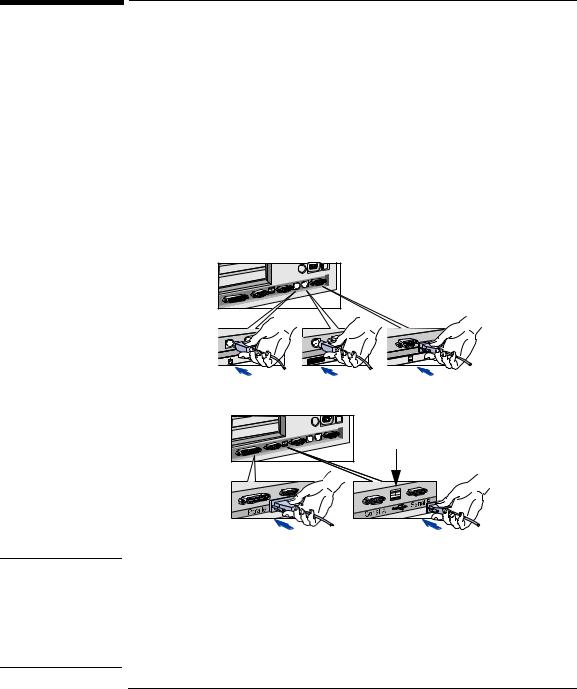
NOTE
1 Setting Up and Using Your PC
Connecting the Mouse, Keyboard, Display and Printer
Connecting the Mouse, Keyboard, Display and Printer
Connect the mouse, keyboard, and display to the back of the computer.
The connectors are shaped to go in one way only. Tighten the display cable attachment screws.
Connect the printer cable to the back of the computer and tighten the attachment screws. Use the connector labeled:
•Parallel (25-pin parallel connector) for a parallel device
•Serial A (9-pin serial connector) for a serial device
•Serial B (9-pin serial connector) for a second serial device.
Connections for Models with Integrated Video Display
Mouse Keyboard Display
(USB—see note below)
Parallel Connector |
Serial Connectors |
The Universal Serial Bus (USB) connectors are between the serial connectors and can be used for USB accessories. Most USB accessories are automatically configured as soon as they are physically attached to the PC. USB is not supported by all operating systems. If the USB drivers are not available on your PC, they can be obtained from HP’s electronic services.
3
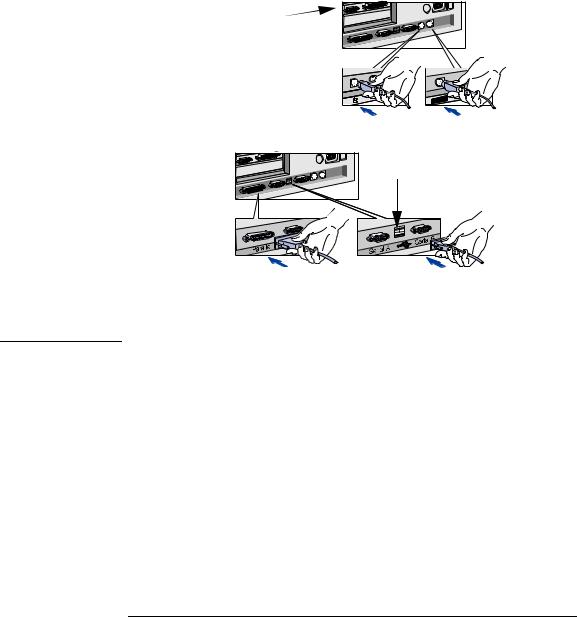
1 Setting Up and Using Your PC
Connecting the Mouse, Keyboard, Display and Printer
Connections for Models with MGA Millennium Video Board
If your PC has a MGA Millennium video board, use the following connectors.
MGA Millenium video display connector
Mouse Keyboard
(USB—see note below)
Parallel Connector |
Serial Connectors |
NOTE |
The Universal Serial Bus (USB) connectors are between the serial |
|
connectors and can be used for USB accessories. Most USB accessories |
|
are automatically configured as soon as they are physically attached to |
|
the PC. USB is not supported by all operating systems. If the USB |
|
drivers are not available on your PC, they can be obtained from HP’s |
|
electronic services. |
|
|
4
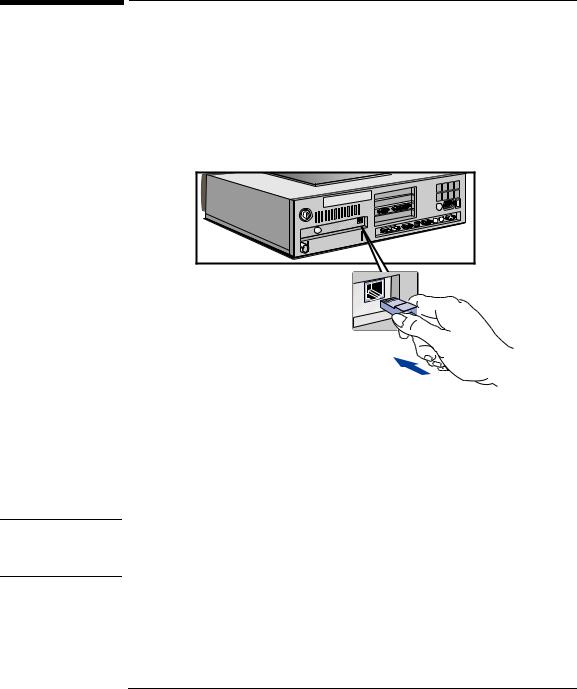
NOTE
1 Setting Up and Using Your PC
Connecting to a Network
Connecting to a Network
If your PC comes with a network connector, let your Network Administrator know you are connecting your PC to the network. Connect the network cable to the RJ-45 UTP (Unshielded Twisted Pair) LAN connector.
To enable your network connection, refer to the Integrated Network Interface Submenu in the Configuration Menu of the HP Setup program. (You can find additional information in the online Network Administrator’s Guide.)
If you need a BNC Coax connector to connect to the network, you can install an optional BNC coax adapter (order HP D3979A). Refer to "Installing a BNC Coax Adapter", on page 38.
5
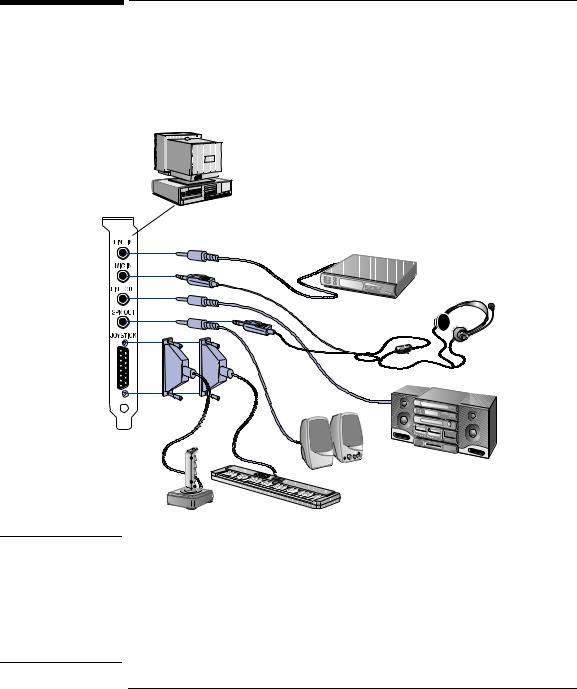
WARNING
1 Setting Up and Using Your PC
Connecting Audio Accessories
Connecting Audio Accessories
If your PC has multimedia capabilities, it will have a Headphones jack and a Microphone jack on the rear panel. An audio Line In jack, an audio Line Out jack, and a MIDI interface connector (“SPK OUT”) are also located on the rear panel.
NOTE
The internal speaker and the Line Out jack on the rear of your PC are deactivated when you use the Headphones jack.
The internal speaker is deactivated when you use the Line Out jack.
The audio accessories shown
here (microphone, speakers, and hifi system) are not supplied with your PC.
To avoid discomfort from unexpected noise, always turn the volume down before connecting headphones or speakers.
Listening to loud sounds for prolonged periods may permanently damage your hearing. Before putting on headphones, place them around your neck and turn the volume down. When you put on the headphones, slowly increase the volume until you find a comfortable listening level, and leave the volume control in that position.
6
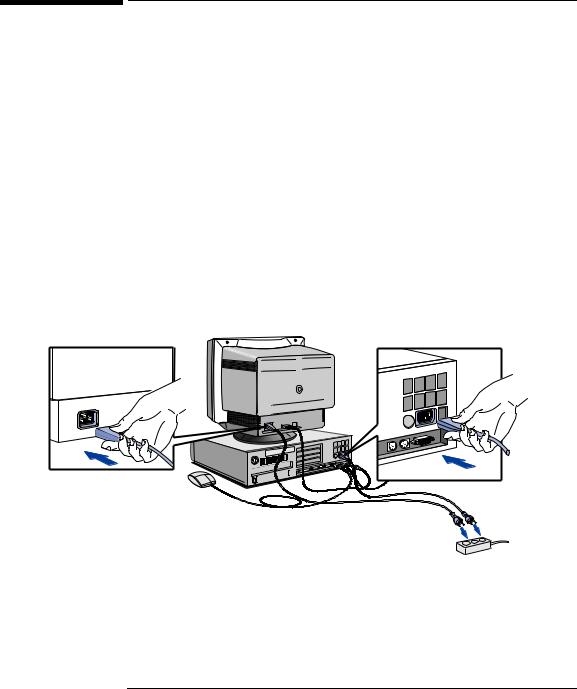
1 Setting Up and Using Your PC
Connecting the Power Cables
|
|
Connecting the Power Cables |
|||||||||||||
|
|
|
|
|
|
|
|
|
|
|
|
|
|
|
|
WARNING |
|
For your safety, always connect the equipment to a grounded wall |
|||||||||||||
|
|
outlet. Always use a power cable with a properly grounded plug such |
|||||||||||||
|
|
as the one provided with this equipment or in compliance with your |
|||||||||||||
|
|
national regulations. This PC is disconnected from the power by |
|||||||||||||
|
|
removing the power cable from the power outlet. This means the PC |
|||||||||||||
|
|
must be located close to a power outlet that is easily accessible. |
|||||||||||||
|
|
|
|
|
|
|
|
|
|
|
|
|
|
|
|
|
1 |
If fitted, remove the label covering the computer’s power connector. |
|||||||||||||
|
2 |
Connect the power cords to the display and the computer. (The |
|||||||||||||
|
|
connectors are shaped to go in one way only.) |
|||||||||||||
|
3 |
Connect the display’s power cord and the computer’s power cord to |
|||||||||||||
|
|
a grounded outlet. |
|||||||||||||
|
Display |
|
|
|
|
|
|
|
|
|
|
|
Computer |
||
|
Power Cord |
|
|
|
|
|
|
|
|
|
|
|
Power Cord |
||
|
|
|
|
|
|
|
|
|
|
|
|
|
|
|
|
|
|
|
|
|
|
|
|
|
|
|
|
|
|
|
|
|
|
|
|
|
|
|
|
|
|
|
|
|
|
|
|
|
|
|
|
|
|
|
|
|
|
|
|
|
|
|
|
|
|
|
|
|
|
|
|
|
|
|
|
|
|
|
|
|
|
|
|
|
|
|
|
|
|
|
|
|
|
|
|
|
|
|
|
|
|
|
|
|
|
|
|
|
|
|
|
|
|
|
|
|
|
|
|
|
|
|
|
|
|
|
|
|
|
|
|
|
|
|
|
|
|
|
|
|
|
|
|
|
|
|
|
|
|
|
|
|
|
|
|
|
|
|
|
|
|
|
|
|
|
|
|
|
|
|
|
|
|
|
|
|
|
|
|
|
|
|
|
|
|
|
|
|
|
|
|
|
|
|
|
|
|
|
|
|
|
|
|
|
|
|
|
|
|
|
|
|
|
|
|
|
|
|
|
|
|
|
|
|
|
|
|
|
|
|
|
|
|
|
|
|
|
|
|
|
|
|
|
|
|
|
|
|
|
|
|
|
|
|
|
|
|
|
|
|
|
|
|
|
|
|
|
|
|
|
|
|
|
|
|
|
|
|
|
|
|
|
|
|
|
|
|
|
|
|
|
|
|
|
|
|
|
|
|
|
|
|
|
|
|
|
|
|
|
|
|
|
|
|
|
|
|
|
|
|
|
|
|
|
|
|
|
|
|
|
|
|
|
|
|
Grounded Outlet
7

1 Setting Up and Using Your PC
Your PC’s Hardware Control Panel
Your PC’s Hardware Control Panel
Your PC’s hardware control panel is on the front of your PC.
Power on Status Light |
Hard Disk Activity Light |
Power On/Off |
Volume Control |
Speaker Out for Headset |
(Optional—see note below) |
(Optional—see note below) |
Power On/Off Button Press this button to turn the power on or off to your PC.
Hard Disk Activity Light This light glows/flickers when your hard disk drive is being accessed. The hard disk activity light only works if you have an IDE hard disk drive, which comes with your Vectra PC. If you replace this drive with a SCSI hard disk drive, this light will not work.
NOTE |
If your PC comes with an audio board, the front panel will have controls |
|
for the audio board. |
|
|
8

NOTE
1 Setting Up and Using Your PC
Starting and Stopping Your PC
Starting and Stopping Your PC
If you are starting your PC for the first time, refer to "Starting the PC for the First Time", on page 10. To stop your PC, refer to "Stopping Your PC", on page 12.
Starting Your PC
1Before you start your PC, first switch on the display.
2Start your PC in one of these ways:
•press the power button on the front panel
•press the space bar.
When you switch on the computer, the computer carries out the Power-On-Self-Test (POST) while the Vectra logo is displayed. If you wish to view the POST details, press  to get the HP Summary Screen. If there is an error in the POST, the error will automatically be displayed. For details, refer to "If a POST Error Message is Displayed", on page 47.
to get the HP Summary Screen. If there is an error in the POST, the error will automatically be displayed. For details, refer to "If a POST Error Message is Displayed", on page 47.
3If you have set a password in the PC’s Setup program, the password prompt displays after the POST has completed. If the Password
prompt is displayed, type your password and press  to be able to use the PC.
to be able to use the PC.
9

CAUTION
NOTE
1 Setting Up and Using Your PC
Starting and Stopping Your PC
Starting the PC for the First Time
If your PC has preinstalled software, it is initialized the first time you start the PC. The software initialization process takes approximately three minutes. This process sets up the software in your language and sets up your software to use the hardware installed in your computer (you can change the settings after the software has been initialized).
You may also be asked to select which operating system you want to use, for example Windows 3.11 or Windows 95. Once you have confirmed your selection of the operating system, you cannot change that selection. The operating system that you have NOT chosen will be deleted from the computer’s hard disk
Initializing Your Software
Do NOT switch OFF the PC while the software is being initialized—this could cause unexpected results.
To initialize your software:
1Turn on the display first, and then the PC.
When the PC is switched on, the Vectra Logo is displayed. The PC
performs a Power-On-Self-Test (POST). Press  if you want to view the POST details in the HP Summary Screen (refer to the "HP Setup Program", on page 66.
if you want to view the POST details in the HP Summary Screen (refer to the "HP Setup Program", on page 66.
If an error is detected during the Power-On-Self-Test, the PC will
automatically display the error. You may be prompted to press  to start the Setup program to correct the error.
to start the Setup program to correct the error.
10

1 Setting Up and Using Your PC
Starting and Stopping Your PC
2The software initialization routine starts. It displays the software license agreement, gives you an opportunity to read Working in Comfort (ergonomic advice for computer users), and then asks questions about the PC. For example:
•The name of the person who will use the PC and your company name. (If necessary, the name of the user can be modified later.)
•The current date and time.
•The type of printer (for example, HP LaserJet 4M). This is shown on the front of the printer. You also need to enter the connection used by the printer.
•The model number of your display. The display’s model number is shown on the cover of the manual supplied with the display and on a label on the rear of the display.
•Depending on which model PC you have, you may also be asked to select which operating system you want to use, Windows 3.11 or Windows 95. Once you have confirmed your selection of the operating system, you cannot change that selection. The operating system that you have NOT chosen will be deleted from the computer’s hard disk
3While the initialization program is running, you can complete the Warranty Registration card that you will find inside the back of this manual. When the initialization routine has finished, click on OK and the PC will restart.
After Your PC Has Restarted
Set the keyboard to a comfortable position.
Adjust the display screen’s brightness and contrast to suit your needs. If the picture does not fill the screen or is not centered, adjust it using the controls on the display. Refer to the display’s manual for details.
11

1 Setting Up and Using Your PC
Starting and Stopping Your PC
Creating Master Diskettes
It is very important that you create master diskettes for your preloaded software as soon as possible. HP recommends that you use new diskettes. If you need to restore the preloaded software on your PC, you can use these diskettes to do so.
For details on how to create these diskettes, refer to the documentation for your operating system.
Stopping Your PC
To stop the PC, make sure that you have exited all programs and the operating system (if necessary), and then press the power button on the control panel.
Refer to the operating system manual for details of how to exit the operating system.
12

NOTE
1 Setting Up and Using Your PC
Setting Passwords
Setting Passwords
You can set two passwords, the administrator password and the user password, to provide two levels of protection for your PC. You set both passwords in the Security menu group of the Setup program.
Setting an Administrator Password
Set the Administrator Password to protect the PC’s configuration in Setup. An Administrator Password can provide a power-on password prompt to prevent your PC being started or used in your absence. You can also use this password to start the PC when the keyboard (and mouse) are locked—you must type the password and press 
to unlock the keyboard (refer to "Power-On Password", in the HP Setup program—refer to "HP Setup Program", on page 66).
If you have set both an Administrator Password and a User Password, and you enter the Setup program by using the User Password, you will be restricted in your ability to change setup items. If you enter the Setup program with an Administrator Password, you will have no restrictions.
To set an Administrator Password:
1Start the Setup Program. Refer to "HP Setup Program", on page 66.
2Select the Security menu group.
3Select the “Administrator Password” submenu.
4Choose the “Set Administrator Password” setup item. You will be asked to enter your password twice. Be sure to save your changes before you exit the Setup program.
To remove the password, follow the same procedure as to set a password, but do not enter anything in the password field. Press  and then press
and then press  a second time to confirm your action.
a second time to confirm your action.
If you forget your password, refer to "If You Have Forgotten Your Password", on page 57.
13

1 Setting Up and Using Your PC
Setting Passwords
Setting a User Password
A user password can only be set if an Administrator Password has already been set.
Set a User Password to:
•provide a power-on password prompt to prevent your PC being started or used in your absence
•start the PC when the keyboard (and mouse) are locked—you must
type the password and press  to unlock the keyboard (refer to "Power-On Password", in the HP Setup program—refer to "HP Setup Program", on page 66).
to unlock the keyboard (refer to "Power-On Password", in the HP Setup program—refer to "HP Setup Program", on page 66).
If you have set both an Administrator Password and a User Password, and you enter the Setup program by using the User Password, you will be restricted in your ability to change setup items. If you enter the Setup program with an Administrator Password, you will have no restrictions.
To set a User Password:
1 Start the Setup Program. Refer to "HP Setup Program", on page 66.
2 Select the Security menu group.
3 Select the “User Password” submenu.
4 Choose the “Set User Password” setup item. You will be asked to enter your password twice. Be sure to save your changes before you exit the Setup program.
|
To remove the password, follow the same procedure as to set a |
||||
|
password, but do not enter anything in the password field. Press |
||||
|
|
|
and then press |
|
a second time to confirm your |
|
|
|
|
||
|
action. |
|
|
||
|
|
|
|
|
|
NOTE |
If you forget your password, refer to "If You Have Forgotten Your |
||||
|
Password", on page 57. |
|
|
||
|
|
|
|
|
|
14

1 Setting Up and Using Your PC
Using Power Management
Using Power Management
Power management enables you to reduce the PC’s power consumption when you are not using the PC. To configure power management, refer to "Power Menu Items" in the HP Setup program (refer to "HP Setup Program", on page 66).
Refer to your operating system documentation for detailed information about the capabilities of your operating system to implement power management.
This PC’s power management complies with the Energy Star Computers Program initiated by the United States Environmental Protection Agency.
Additional Information and Help
Additional information about your PC is preloaded on your PC’s hard disk drive. This information includes:
•New features—what is new and special about your PC
•Using your PC—simple, “how-to-use” guidelines about using your PC
•Working in comfort—guidance on ergonomic issues
•Inside your PC—describes the basic parts of your PC, how to upgrade, and how to optimize performance
•HP support—similar to chapter 4 in this User’s Guide
•Glossary.
15

1 Setting Up and Using Your PC
Additional Information and Help
16

2
How to Install Accessories In Your PC
This chapter explains how to install accessories, such as extra memory, accessory boards, and additional disk drives, in your PC.
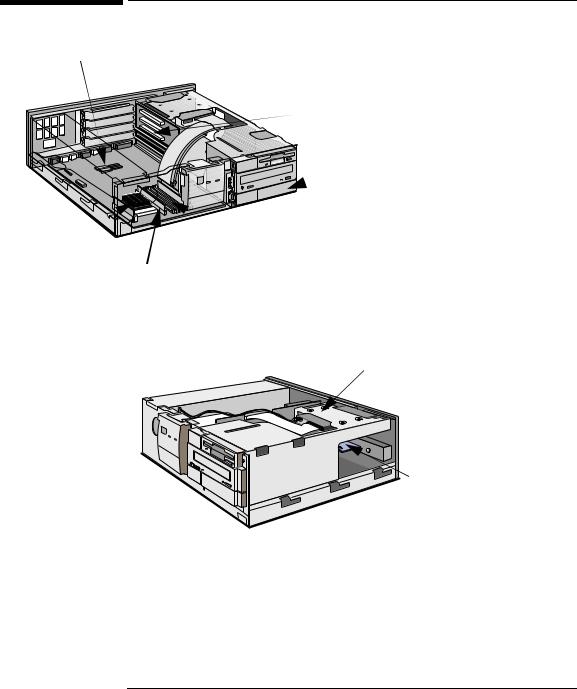
2 How to Install Accessories In Your PC
Accessories You Can Install
Accessories You Can Install
Video Memory
Processor 
Cache Memory
Up to Four Accessory Boards
(Some slots may come with pre-installed boards.)
Front-Access Device Shelf
 5.25-inch 1.2-MB flexible disk drive
5.25-inch 1.2-MB flexible disk drive
Tape Drive
Main Memory Modules (32-bit EDO):
8 MB kit (2 x 4 MB modules)
16 MB kit (2 x 8MB modules)
32 MB kit (2 x 16 MB modules)
64 MB kit (2 x 32 MB modules)
(Pairs of identical modules must be installed.)
One internal mass storage device
Network LAN Board (UTP)
(on some models)
18
